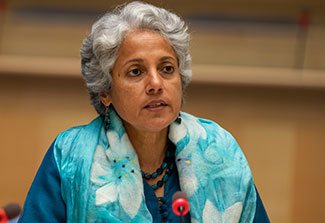World Health Organization (WHO) science chief evaluates COVID-19 response
November/ December 2021 | Volume 20 Number 6
 Photo by WHO/Christopher BlackWHO Chief Scientist Dr. Soumya Swaminathan urged the ESSENCE on Health Research members to continue to push for improved health research capacity in low- and middle-income countries.
Photo by WHO/Christopher BlackWHO Chief Scientist Dr. Soumya Swaminathan urged the ESSENCE on Health Research members to continue to push for improved health research capacity in low- and middle-income countries.
Despite
huge global investments in COVID-19 research over the past two years, there was a disappointing lack of coordination and lack of response from existing clinical trials networks, WHO Chief Scientist Dr. Soumya Swaminathan noted during a recent meeting of
ESSENCE on Health Research. She encouraged the group of funders to reflect on the lessons learned and have a very open and frank discussion about the changes that need to be made. “I know that it's not easy for any research agency to suddenly do things which are out of the ordinary and to start funding things which may not otherwise be within the remit,” she said. “We need to think about the idea that what happens in an emergency has to be different from what happens when it’s business as usual.”
ESSENCE is an initiative hosted by WHO that is intended to increase the impact of support provided for research capacity strengthening in low- and middle-income countries (LMICs). Partly in response to the 2013-2016 Ebola outbreak that highlighted the lack of research capacity in West Africa, ESSENCE formed a working group to improve coordination and collaboration among funders of health research capacity strengthening, using data and metrics to increase effectiveness and equity. ESSENCE also developed a review mechanism of investments with the overall goal of increased research on national health priorities, as well as improved pandemic preparedness. The ultimate goal is to reduce the number of countries with very limited research capacity.
Swaminathan recalled the WHO scientific gathering in February 2020 that was tasked with creating a roadmap for the development of COVID-19 diagnostics, vaccines and therapeutics. The resulting “R&D Blueprint” included epidemiological research, infection prevention and control research, and social and behavioral research. “But then what happened was that one did not see collaboration and coordination across research funders that perhaps could have helped to set up large multi-country studies using common protocols and common frameworks to measure and report on these elements,” said the former Fogarty fellow. Inequities persisted with 97% of research support from the world’s top dozen funders remaining in high-income countries.
We need to think about the idea that what happens in an emergency has to be different
from what happens when it’s business as usual.
— Dr. Soumya Swaminathan, WHO Chief Scientist
Disappointed, the WHO responded by establishing an international collaboration to identify life-saving treatments for COVID-19.
The Solidarity trial immediately revealed hidden problems. Some of the 50-plus country participants cleared ethics and regulatory hurdles within a week. Other nations took six months. “I think every organization has lessons that they can learn and improvements they can make around the research ecosystem,” said Swaminathan.
Vaccine and drug research was overplayed, and social and behavioral science research was neglected, observed the WHO chief. “Everyone paid the price for not having social and behavioral considerations come into policymaking early enough.” Swaminathan also questioned the need for “300 trials of hydroxychloroquine, most not able to answer the primary question of whether the drug has any beneficial effects.” Instead of this “waste of resources,” a coordinated approach might have led some hydroxychloroquine investigators to shift their focus to another potential repurposed drug. Another problem: Most vaccine studies focused on the modern mRNA and DNA inoculations, without enough attention paid to the traditional vaccines primarily used in LMICs. Lacking too were large trials of non-pharmaceutical interventions— studies of mask-wearing, for example.
Undoubtedly the pandemic also led to scientific gains, such as advances made in data exchange. “Genomic sequence data sharing helped us track the evolution of the virus,” Swaminathan noted. Many principal investigators also pooled their data so that the WHO could create “living” guidelines based on available information. “As new research comes out, recommendations are updated. It is timely and saves a lot of effort once it’s on a digital platform,” she said. Disseminating this model to countries will help health ministries update other guidelines, such as those for antenatal care or malaria.
Swaminathan called for even more open and timely sharing of data, accompanied by the sharing of benefits across higher and lower resource nations in the form of publications or access to health products and technologies. “I think researchers in general want to collaborate,” she observed. “I think they’re driven by scientific curiosity.” She encouraged ESSENCE to build on this progress and ensure global representation is included in these platforms.
The meeting also included a presentation of a Fogarty analysis of health research capacity, conducted by Janelle Cruz. She noted that seven LMICs rank among the top 20 nations with the highest health research capacity. In order of strength, they are China, India, Brazil, Mexico, Thailand, Russian Federation and Turkey. Cruz’s takeaway from her review of 180 nations: “Demography is not destiny—good research capacity is present in some smaller, less wealthy and less developed countries. Others can follow.” Next steps include studying high-capacity outliers to determine best practices, while addressing barriers and assessing priorities in countries with low research capacity.
More Information
To view Adobe PDF files,
download current, free accessible plug-ins from Adobe's website.